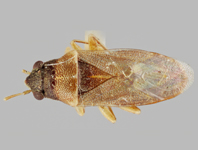Abstract
The genus Xylaplothrips is re-diagnosed, 11 species are listed as appropriately included in this genus of which three are new combinations from Haplothrips (X. acaciae; X. collyerae; X. gahniae). A further six species are listed as incertae sedis within Xylaplothrips and a key is provided to the four species of this genus known from Australia including X. anarsius sp.n. The genus Mesandrothrips is recalled from synonymy with Xylaplothrips, and a list is provided of 20 appropriately included species of which 14 are new combinations from Xylaplothrips (M. caliginosus; M. clavipes; M. darci; M. dubius; M. emineus; M. flavitibia; M. flavus; M. inquilinus; M. montanus; M. pictipes; M. pusillus; M. reedi; M. subterraneus; M. tener), and one is a new combination from Haplothrips (M. inquinatus). A key is provided to 10 species of this genus known from Australia, including three species transferred from Haplothrips, together with M. austrosteensia sp.n., M. googongi sp.n., M. kurandae sp.n., M. lamingtoni sp.n. and M. oleariae sp.n. The type species, M. inquilinus, is widespread across Southeast Asia as an invader of thrips galls, and Haplothrips darci Girault based on a single female from Queensland is considered closely related.
References
Bagnall, R.S. (1919) Brief descriptions of new Thysanoptera X. Annals and Magazine of Natural History, Series 9, 4, 253–277.
https://doi.org/10.1080/00222931908673889
Cavalleri, A., Lindner, M.F. & Mendonça Jr., M. de S. (2016) New Neotropical Haplothripini (Thysanoptera: Phlaeothripidae) with a key to Central and South American genera. Journal of Natural History, 50, 1389–1410.
https://doi.org/10.1080/00222933.2015.1113316
Girault, A.A. (1930) New pests from Australia. VIII. Published privately, Brisbane, 5 pp.
Karny, H. (1920) Nova Australska Thysanoptera, jez nashbiral Mjöberg. Casopis Ceskoslovensk spolecnosti entomologisck, 17, 35–44.
Karny, H. (1921) Beitraege zur Malayischen Thysanopterenfauna. IV. Thysanopteren von Hevea. V. Thysanopteren an Tee. Treubia, 2, 37–83.
Minaei, K., Fekrat, L. & Mound, L.A. (2018) The genus Neoheegeria with a new species from Iran exhibiting wing-dimorphism (Thysanoptera: Phlaeothripidae). Zootaxa, 4455 (3), 563–570.
https://doi.org/10.11646/zootaxa.4455.3.12
Minaei, K. & Mound, L.A. (2008) The Thysanoptera Haplothripini (Phlaeothripidae) of Iran. Journal of Natural History, 42, 2617–2658.
https://doi.org/10.1080/00222930802354159
Mound, L., Collins, D. & Hastings, A. (2018) Thysanoptera Britannica et Hibernica. A guide to British thrips. Lucidcentral.org, Identic Pty Ltd, Queensland, pp.
Mound, L.A., Dahiya, N. & Yerbanga, R.S. (2014) Systematic relationships of Vuilletia and Senegathrips (Thysanoptera, Phlaeothripinae) from galls on the West African shrub Guiera senegalensis. Zootaxa, 3811 (1), 146–148.
https://doi.org/10.11646/zootaxa.3811.1.10
Mound, L.A. & Minaei, K. (2007) Australian insects of the Haplothrips lineage (Thysanoptera—Phlaeothripinae). Journal of Natural History, 41, 2919–2978.
https://doi.org/10.1080/00222930701783219
Mound, L.A. & Okajima, S. (2015) Taxonomic Studies on Dolichothrips (Thysanoptera: Phlaeothripinae), pollinators of Macaranga trees in Southeast Asia (Euphorbiaceae). Zootaxa, 3956 (1), 79–96.
https://doi.org/10.11646/zootaxa.3956.1.4
Mound, L.A. & Walker, A.K. (1986) Tubulifera (Insecta: Thysanoptera). Fauna of New Zealand, 10, 1–140.
Okajima, S. (2006) The Suborder Tubulifera (Thysanoptera). The Insects of Japan, 2. The Entomological Society of Japan, Touka Shobo Co. Ltd., Fukuoka, 720 pp.
Pitkin, B.R. (1973) A revision of the Australian Haplothripini, with descriptions of three new species (Thysanoptera: Phlaeothripidae). Journal of the Australian Entomological Society, 12, 315–339.
https://doi.org/10.1111/j.1440-6055.1973.tb01680.x
Pitkin, B.R. (1976) A revision of the Indian species of Haplothrips and related genera (Thysanoptera: Phlaeothripidae). Bulletin of the British Museum (Natural History), Entomology, 34, 221–280.
Priesner, H. (1921) Haplothrips-Studien. Treubia, 2, 1–20.
Priesner, H. (1928) Die Thysanopteren Europas. Abteilung IV. F. Wagner verlag, Wien, 187 pp. [pp. 569–755]
Priesner, H. (1933) Indomalayische Thysanopteren IV. [Teil 2]. Konowia, 12, 69–85 + 307–318.
Schille, F. (1911) Nowe formy Praylzencow (Thysanopterorum genera et species novae). Krakow Sprawozdania Komisji Fizyograficznej, 45, 3–10.
ThripsWiki (2019) ThripsWiki—providing information on the World’s thrips. Available from: http://thrips.info/wiki/Main_Page (accessed 19 April 2019)
Tree, D.J. & Mound, L.A. (2009) Gall-induction by an Australian insect of the family Thripidae (Thysanoptera: Terebrantia). Journal of Natural History, 43, 1147–1158.
https://doi.org/10.1080/00222930902807767

